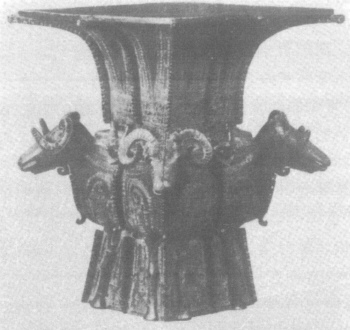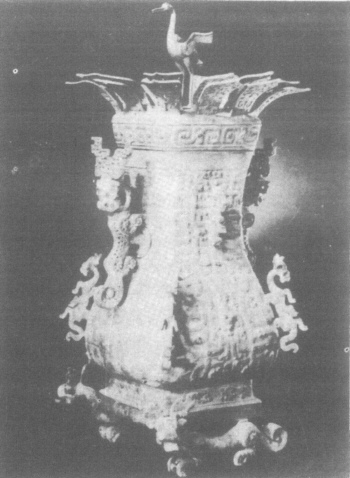Chapter 4 Chapter 2 Bronze Sculpture
The exquisite patterns of Shang and Zhou bronzes have always been admired by scholars and artists.If the practical function of the bronze ware is put aside, the bronze ware as a whole is also a round sculpture with exquisite shape.The production of bronze ware mainly goes through several stages of mold making, mold turning, and casting. Among them, making mold molds is to use clay to shape or use stone to carve various patterns and shapes, which is in itself a sculpture creation.Bronze ware that was cast as a whole or cast in pieces and then combined still reflects the style of clay molds and stone molds.The bronze wares of Shang and Zhou Dynasties, no matter how big or small, have a kind of exquisite detail and overall majestic beauty.For example, the Siyang square statue (Shang) unearthed in Ningxiang, Hunan, the beast-faced elephant head (lei Lei, Western Zhou) unearthed in Pengxian County, Sichuan, the dragon ear statue (Chunqiu) unearthed in Nanling, Anhui, and the gold and silver dragon and tiger case (Warring States) unearthed in Xichuan, Henan. , are all works of this kind of vivid and exquisite part, magnificent and splendid whole. (Figure 4)

Figure 4 Siyang Square Zun Bronze Merchant Unearthed in Ningxiang, Hunan
The patterns (relief carvings) on Chinese bronze wares are world-renowned for their exquisiteness, craftsmanship, and fantasy. They are also unique among the artworks of various ancient civilizations in the world at the same time.Deliberately beautifying utensils can be described as a fine tradition of the Chinese nation.The dazzling painted pottery of the Neolithic Age has already begun.If we explore it from the depth of culture, it should also be attributed to the diligent pursuit of "literature" by the Chinese nation since ancient times.The pursuit of "literature" in primitive society at least includes the worship of ancestors and elves (entertaining gods, thanking gods, etc.), warding off evil spirits (the theory of tattooing into water to avoid dragons, etc.), showing off (expression of strength, attraction to the opposite sex, etc.) several purposes.Entering a civilized society, although some great philosophers put more emphasis on quality than writing on the issue of writing and quality, and even proposed "deleting articles" and "scattering colorful", but because writing (commonly used with "texture") has "pleasing to the eye" and teaching assistants Instead of transforming, accommodating human feelings, accommodating the principles of nature, and entertaining the gods, "wen" has more and more profound connotations. "Zuo Zhuan Xuangong Three Years" records Wang Sunman's words: "In the past Xia, the people were virtuous, and they drew objects from afar, paid nine pieces of gold, cast tripods and objects, prepared all kinds of objects, and made the people know the gods. "The text here (casting a tripod like an object, and preparing everything for it) played a role in distinguishing good from evil in the Xia Dynasty (making people aware of God's treachery).Confucius said: "Zhou was supervised in the second generation, and I was so depressed that I followed Zhou." ("The Analects of Confucius Bayi [yiyi]") The text here adds the connotation of the laws and regulations of the Western Zhou Dynasty. "Mandarin · Jinyu Five" records Ning Ying's saying: "A husband's appearance is the beauty of love; speech is the opportunity of appearance. The body is love, and it is formed in the middle. Words are the text of the body. Words and texts are expressed. When you are united, you can move forward, and when you are separated, you will have a side." The text here was also related to moral cultivation in the Spring and Autumn Period.In the Warring States Period, Xunzi said in his book "Xunzi·Fuguo": "The ancient kings... will use the writing of Mingren, and the obedience of benevolence. Therefore, it is carved and engraved for it, and the article is enough to make it It’s just to distinguish between noble and inferior, not to look at it.” In the Warring States period, Wen also had the function of salute and distinguishing superior and inferior.Developed to the Han Dynasty, Wang Chong's "things are represented by literature, and people are based on literature" ("Lunheng Shujie Pian"), clearly defined "wen" as "heaven", "nature", "virtue" and "quality". The exposed part is an objective reflection of the external world and the internal world.It can be said that from the Three Dynasties to the Han Dynasty, the decorations (including some shapes) of bronze ware expressed the content that represented gods and traitors, images representing high and low, some ideals or moral symbols, and possibly The pursuit of beauty or the expression of a need.
The evolution of the ornamentation of Shang and Zhou bronzes has gone through stages from complex to simple, from simple to complex, and then from complex to simple. Every change has a reason.For the first time, it appeared from the late Yin and Shang Dynasties to the early Western Zhou Dynasty, manifested in the complexity of the sculpture level. At this time, the bronzes were all decorated with middle-relief sculptures, and around the theme decorations (the next plane), they were decorated with shallow-relief clouds and thunder patterns. As a foil, on the medium-relief plane of the theme decoration, many fine cloud and thunder patterns are engraved to form the so-called "three-layer flower" (three-level carving).The first Jane appeared in the late Western Zhou Dynasty. At this time, a large number of inscriptions appeared on the bronze wares. Since the content to be expressed was already achieved in words, there was no need to resort to ornamentation. Therefore, the bronze wares of this period did not pay much attention to appearance decoration. Bronze ware decorated with several string patterns accounted for a large proportion.During the Spring and Autumn Period, due to the advancement of technology, pattern stamps were invented, and a pattern can be repeatedly tapped on a utensil, which once again formed the trend of complex patterns on bronzes.In addition, the development of inlay technology brought about by the use of sharp ironware also increased the variation of bronze decoration.The complexity this time is different from the complexity of the late Yin and Shang Dynasties, mainly not in the number of three-dimensional layers, but in the complexity and fineness of the two-dimensional decoration.The decoration of bronze wares in the Warring States period returned to the simple style again. Some bronze wares, such as pots, beans, and mirrors, often cast large-scale flat carving portraits.Birds, animals, vegetation, pavilions, gardens, feasts, battles, fishing and hunting, sericulture and other real social life content appear on bronzes, while the rest of the various decorations tend to be more and more simplified.The rough-lined descriptions of several transitional periods in the Shang and Zhou bronze wares were actually several important transitional periods in the social and intellectual history of the Shang and Zhou dynasties.That is to say, from the worship of ghosts and witchcraft in the slave society to the respect for heaven and virtue in the feudal lord society, then to the collapse of rites and music in the budding period of the feudal landlord economy when the royal power fell, and then to the contention of a hundred schools of thought and the destruction of the mandate of heaven in the time of disputes among nations.Generally speaking, this whole process is a development process of human nature becoming more and more awakened.This process can also be reflected in the specific form of bronze decoration in a tortuous manner.For example, the bronze wares of the Yin and Shang dynasties have the pattern of Kui [kui sunflower, a dragon-shaped animal in ancient legends] with wide-eyed eyes and wide-open mouth, and Taotie [taotie Taotie, a ferocious beast in ancient legends]. , Shang and Western Zhou bronzes were engraved with the shape of its head as decoration, and all other decorations echoed and arranged around these two decorations.In the late Western Zhou Dynasty, the mysterious and majestic Kui and Taotie patterns were gradually eliminated. Even the Taotie patterns that sometimes appeared were often reduced in size and used as subordinate decorations (such as decoration on the upper end of the bronze vessel); Some geometric patterns such as curved pattern, tile pattern, ring pattern, double ring pattern and scale pattern became popular.During the Spring and Autumn Period, the meticulous and meticulously carved patterns of panchi (panchi) and panzhi (huihui) were popular, and at the same time, portrait techniques reflecting the activities of animals, mountains and forests, and figures also appeared.Some animal sculptures on bronze wares present an upward and stretched style (such as lotus crane square pot). (Figure 5) During the Warring States period, there were more portraits of personnel activities on bronze wares, and the decorations on bronze wares also changed from solemn to relaxed, and from dull to lively.
Judging from the artistic techniques and artistic achievements of sculpture, the bronze wares of Shang and Zhou Dynasties have the following characteristics:
(1) The theme is clear.This clear feature is mainly through radiation (arranged around a theme decoration), symmetry (with a theme decoration as the balanced center point of various decorations), surround (the theme pattern is distributed in the main decorative part of the utensils), and beyond ( Thematic decoration or partial sculpture has a rising momentum away from the utensils) These methods are reflected.
(2) Occupy the largest space.This kind of occupation is mainly through multi-layer engraving, such as three-layer fancy, occupying more three-dimensional space; or distorting the shape in one plane, occupying as much as possible two-dimensional space.
(3) The complementarity of solemnity and relaxation.This kind of complementarity can be reflected in the shape and decoration of the vessel (the complementarity of solemnity, majesty and lightness, and liveliness), as well as the theme and background content (complementation of dullness, stagnation and liveliness, and flow), etc.

Figure 5 Bronze Spring and Autumn Lotus Square Pot unearthed in Xinzheng, Henan

Figure 4 Siyang Square Zun Bronze Merchant Unearthed in Ningxiang, Hunan

Figure 5 Bronze Spring and Autumn Lotus Square Pot unearthed in Xinzheng, Henan
